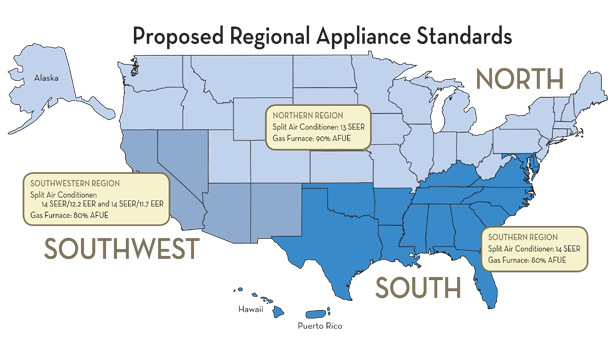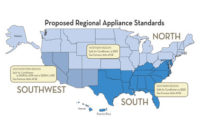How the Standards Were Developed
Originally, the idea for regional standards was proposed in a comprehensive energy bill passed in 2007, the Energy Independence and Security Act (EISA). The EISA specifically granted the DOE the authority to make separate standards for HVAC equipment based on geographic region.
According to Steve Yurek, president and CEO of the Air-Conditioning, Heating, and Refrigeration Institute (AHRI), the manufacturers realized that an aggressive DOE was going to set regional standards and wanted to have input on their development. “After DOE got the authority in 2007 to create regional standards, they were going to move to it,” he said. Consequently, AHRI decided to negotiate with energy-efficiency groups to develop a consensus agreement for regional standards, which could be adopted by DOE.
Yurek noted that if manufacturers had entered the process later, the industry would not have had input on the regional map, and the resulting standards could have been much more problematic for the industry. He stated that the manufacturers wanted to minimize the impact of the standards on consumers and the entire supply chain, so they negotiated to keep the regions as large as possible and to minimize the required increases in efficiency.
In October 2009, AHRI announced the consensus agreements and officially submitted it to DOE in January 2010. In June 2011, the DOE released its rulemaking, which adopted language directly from the agreements. Yurek said DOE has used consensus agreements in the past for other rulemakings, so AHRI was not surprised that the department chose to adopt its language.
However, the consensus agreements raised a lot of controversy across the HVAC industry. Charlie McCrudden, vice president, government relations, Air Conditioning Contractors of America (ACCA), noted that he understood AHRI’s concern about the Obama administration taking a very aggressive stance on energy-efficiency standards and how this led to the consensus agreements. “Unfortunately, we were not part of those discussions,” he said. This has led to the continued concern from other industry stakeholders, including contractors and distributors, over the standards.
Current Status of the Rule
Essentially, the rule, which was released by DOE on June 27, 2011, states that new minimum efficiency standards for air conditioners, heat pumps, and furnaces will be dependent on the region of the country in which they are installed. The rule divides the United States into three regions: North, South, and Southwest. The North region comprises states with population-weighted heating degree days (HDD) equal to or greater than 5,000; the South comprises states with population-weighted HDD less than 5,000; and the Southwest comprises Arizona, California, Nevada, and New Mexico.
In the North region, most furnaces will be required to have an AFUE of 90 percent or more. In the South, central air conditioners will be required to have a SEER of 14. Heat pump and oil furnace standards will rise on a nationwide basis.
According to DOE’s website, “The standards established in the final rule will be applied starting May 1, 2013, for non-weatherized furnaces, and January 1, 2015, for weatherized furnaces and central air conditioners and heat pumps.”
Yurek added that AHRI had hoped that DOE would adopt the consensus agreement sooner. “We were very disappointed that it took them almost two years to do so,” he said. “We were hopeful that they would take it back in January 2010.”
However, others are still concerned about the specifics of the rule and how it will impact the industry.
“We view this as a small business issue,” said Jon Melchi, manager of government affairs at Heating, Airconditioning & Refrigeration Distributors International (HARDI).
“It fundamentally changes the way our members do business, especially those that service multistate regions. There has been a 40 percent decline in unitary volumes since the last minimum standards increase from 10 to 13 SEER in 2006, when you couple this with a 2011 that’s headed towards a potential decline in unitary volumes; this rule makes a tough business tougher. A rule like this, while well-intentioned, makes life tougher on small business owners and cuts into their margins.”
Industry Concerns
One issue of concern with the rule is that condensing furnaces are required in the Northern region. In previous rounds of comments on the standards, ACCA, HARDI, and the American Gas Association (AGA) submitted comments noting that it could become cost-prohibitive for consumers to replace a non-condensing furnace with a condensing furnace, which might require venting retrofit measures.
“What we would like to see is a proposal that does not require condensing furnaces in the North or creates exemptions or allowances so some homeowners have an opportunity to replace [their unit] with an 80 percent furnace due to age of the home, income level, or other economic factors,” McCrudden said. “I recognize it would be difficult to write [such] a rule but I think the effort would be well worth it. There has to be a way for the homeowner to have the opportunity to install a new furnace without having the extra cost.”
However, according to Yurek, “The issue [of condensing furnaces] is there but it’s relatively small.” He explained that Canada adopted a 90 percent AFUE standard for furnaces in 2010. “They’ve had some difficulties but have resolved them. Talking to HRAI [Heating, Refrigeration and Air Conditioning Institute of Canada], the number of truly impossible installations is small compared to total installations. We’re working to see what we can do to help come up with solutions.”
How exactly to enforce regional standards is another thorny issue that has yet to be resolved. If the rule goes through, McCrudden noted, DOE will then be required to initiate a rulemaking on enforcement within 90 days. The question, he said, is: “How do you enforce this? There’s no DOE police.”
Melchi added, “The problem with this rule is nobody knows what the enforcement will look like. On something as major as this, to sign off on a new policy without knowing how it will be enforced is completely irresponsible.”
Yet there have been discussions among industry stakeholders about how to develop an enforcement mechanism that will add minimal burden for the entire supply chain. According to Yurek, some of the proposed ideas include expanding the AHRI directory of certified products to include a zip code, and changing product labeling. Yurek noted, however, that it will be easy to correctly label a furnace, but it will be more difficult to label a split system because its rating will depend on the coil it is matched with.
“We need to be realistic — people are going to cheat,” Yurek said. “It’s a small handful that tarnish the rest.” A potential punishment for failing to abide by the new standards would be to require contractors who have installed equipment below the regional standard to install the correct equipment at their cost.
McCrudden added that the ultimate goal would be to develop a practical enforcement proposal that would not only “protect contractors from the moonlighters who are able to get illegal equipment and install it cheaper” but also protect contractors, distributors, and manufacturers from “any unintended consequences or regulatory burdens.”
Waiting to See
AHRI is concerned that the implementation timeline will be difficult for manufacturers to meet, especially if DOE does not adopt the rule as final in October. “We want to make sure that DOE acts as quickly as possible, even now, in adopting those agreements so it gives manufacturers, wholesalers, and contractors the maximum amount of time to adjust their manufacturing processes, inventory, and other things to meet the requirements,” Yurek said.
While it seems likely that DOE will forge ahead with the rule for regional standards and make it effective on Oct. 25, there are still other possibilities. “If adverse comments are received or they [DOE] decide to make changes, then they’d have to kick it out and open it for another round of public comments,” Melchi said.
Both ACCA and HARDI were developing comments to submit to DOE but had not released them at press time. “This is an open process still,” McCrudden said. “As stakeholders, it’s incumbent on everyone to submit comments and allow the process to play out.”
Sidebar: Bumpy Road to Raise Standards
Part of the rationale behind AHRI’s consensus agreements was a desire to avoid a transition like what happened when the DOE raised the air conditioner efficiency standard from 10 to 13 SEER.
“If you talk to manufacturers in the industry and if you talk to wholesalers and contractors, that 10 to 13 SEER had a significant impact on everybody, on the entire distribution service chain,” said Steve Yurek, president and CEO of Air-Conditioning, Heating, and Refrigeration Institute (AHRI). ARI, AHRI’s predecessor organization, opposed the transition and sued DOE when the standard was released, but ultimately withdrew the suit.
“We had less than 18 months to transition from what was then the current efficiency of 10 SEER to 13 SEER, which had significant economic impacts on the manufacturers but also on the entire distribution chain,” Yurek said
“If we hadn’t fought only on principle and had compromised and negotiated, we could have been at 12 SEER or some other efficiency that would have been better served for the economy today and consumers,” he said. “We wouldn’t have seen some of those things we’ve seen if we didn’t stand on those principles. It was a very hard lesson to learn.”
As a result, the manufacturers approached the consensus agreements for furnaces, air conditioners, and heat pumps as a way to sit down at the table and have a say in the standards development process.
Publication date: 10/17/2011








